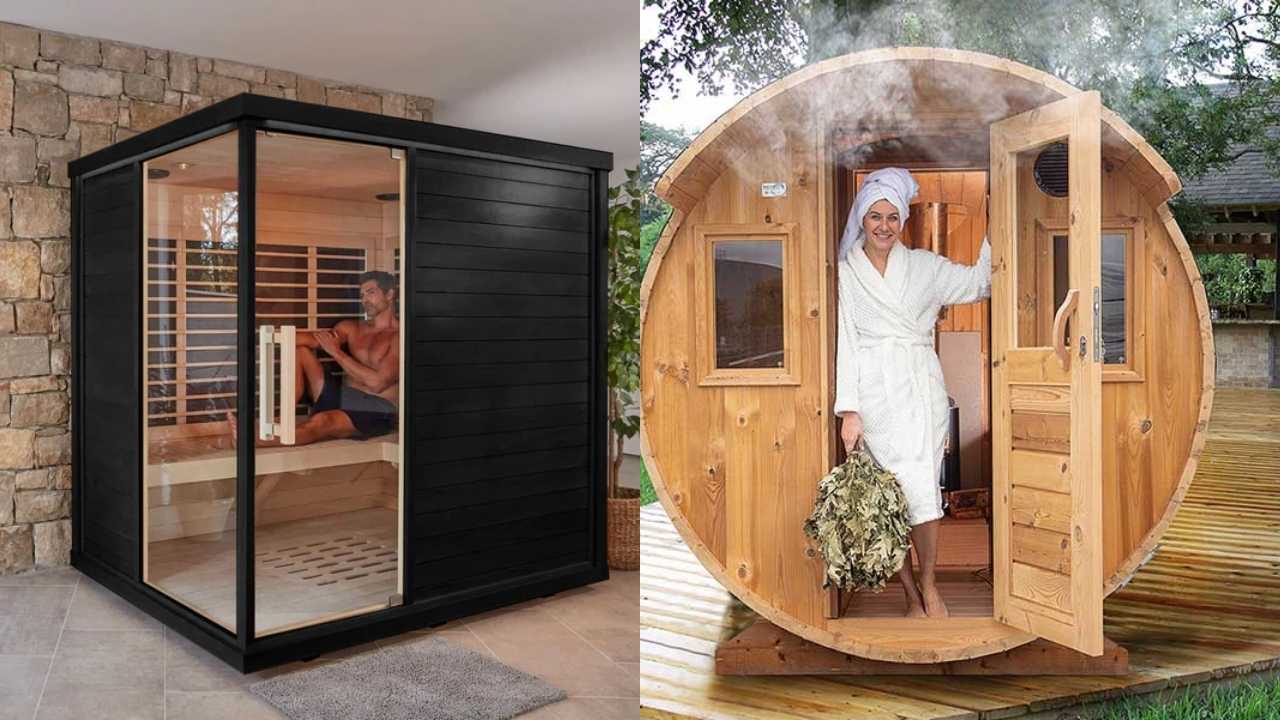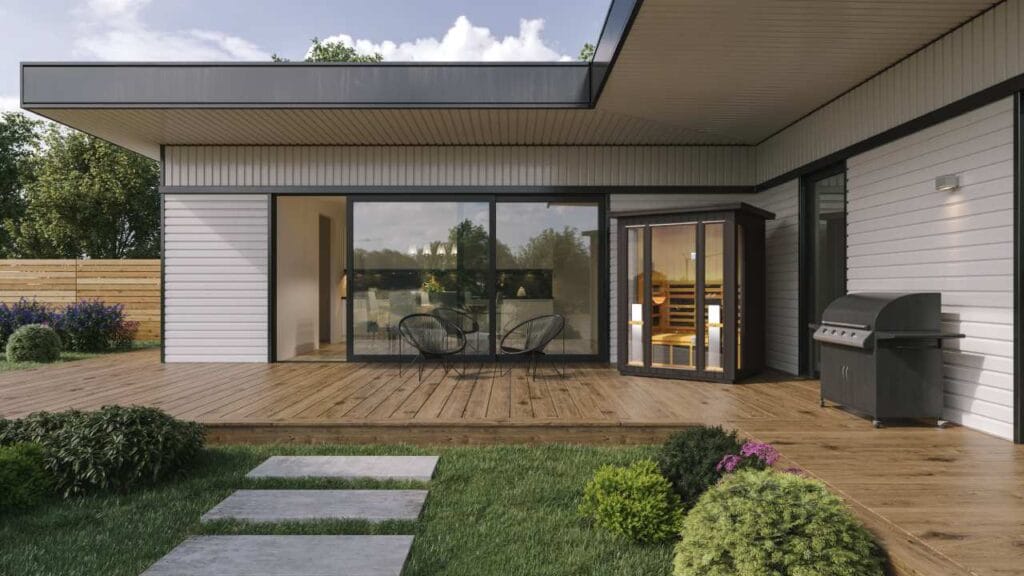Saunas are a fantastic way to relax, improve circulation, and detox your body. Globally, the sauna and spa market is projected to expand from $126.55 billion in 2023 to $181.06 billion by 2028, reflecting a compound annual growth rate (CAGR) of 7.43%.
This increasing interest has led many to consider adding a sauna to their homes. A key decision in this process is choosing between an indoor or outdoor sauna.
But when it comes to deciding between an indoor or outdoor sauna, the choice isn’t always straightforward. Each option has its advantages, so how do you know which is better for you?
I will break down the key differences, benefits, and factors to help you make the right choice.
Indoor vs. Outdoor Sauna: What are the Differences?
What is an Indoor Sauna?
An indoor sauna is a sauna installed inside your home, typically in areas like bathrooms, basements, or even spare rooms. These saunas are designed to fit within your existing living space and offer a private, convenient way to enjoy sauna sessions without stepping outside.
Indoor saunas come in various types, including traditional Finnish saunas that use heated stones and infrared saunas that warm the body directly. They’re often chosen by people who want easy access to a sauna all year round, regardless of weather conditions.
What is an Outdoor Sauna?
An outdoor sauna is a standalone structure built outside, often in a backyard, garden, or near a pool. These saunas are designed to work independently of your home’s interior space and offer a more natural and serene environment for relaxation.
Outdoor saunas come in various styles, from traditional barrel saunas to custom-built cabins. They’re ideal for those who want to enjoy the fresh air and the peaceful ambiance of being outdoors while soaking up the heat. These saunas are particularly appealing if you have the space and love the idea of combining nature with your wellness routine.
Also read: Traditional vs. Infrared vs. Steam Saunas
Key Differences
The main differences between indoor and outdoor saunas come down to space, accessibility, design, privacy, and how well they handle temperature.
- Location and Space: Indoor saunas require space within your home, which might involve repurposing a room or corner. Outdoor saunas, on the other hand, need an open area on your property but don’t take up any indoor square footage.
- Accessibility: Indoor saunas are easier to reach, especially during bad weather, since they’re inside your home. Outdoor saunas may require a short walk, which can feel inconvenient in extreme conditions.
- Design and Aesthetics: Indoor saunas blend into your home’s interior, while outdoor saunas often serve as a focal point in your yard or garden, adding to its overall charm.
- Privacy Considerations: Indoor saunas offer more consistent privacy since they’re within your home. Outdoor saunas might expose you to potential noise or views from neighbors unless positioned carefully.
- Temperature Management: Indoor saunas benefit from your home’s insulation, making them more energy-efficient. Outdoor saunas face weather conditions, requiring extra insulation to maintain heat.
Each type has unique advantages, so deciding which fits better will depend on your specific needs and environment.
Pros and Cons of Indoor Saunas
Indoor saunas offer plenty of benefits, but they also come with some downsides. Here’s a quick breakdown:
Pros
- Year-Round Usability: Indoor saunas are not affected by weather, so you can enjoy them comfortably throughout the year.
- Convenient Access: Since they’re located inside your home, you don’t have to step outside, especially during cold or rainy weather.
- Energy Efficiency: Being indoors means they are easier to insulate, which often translates to lower energy costs for heating.
- Space-Saving Models: Compact options, like infrared saunas, fit well in small spaces, making them great for homes with limited room.
Cons
- Limited by Space: If your home doesn’t have enough room, adding an indoor sauna might require significant remodeling.
- Potential Moisture Issues: Without proper ventilation, saunas can cause humidity problems, leading to mold or structural damage.
- Lacks Outdoor Feel: Indoor saunas don’t offer the same natural ambiance as outdoor setups, which might feel less relaxing for some.
Indoor saunas are a great choice if convenience and year-round access are your priorities, but space and moisture management need careful consideration.
Pros and Cons of Outdoor Saunas
Outdoor saunas bring a unique charm and experience, but they’re not without their challenges. Here’s what you need to know:
Pros
- Natural Ambiance: Being outdoors allows you to enjoy a peaceful, nature-filled setting that enhances relaxation.
- More Spacious: Outdoor saunas often have fewer space restrictions, allowing for larger designs and extra features.
- No Indoor Limitations: Installing an outdoor sauna doesn’t require sacrificing space inside your home or extensive remodeling.
- Customizable Design: You can choose from rustic cabins, modern barrels, or fully custom-built structures to match your outdoor space.
Cons
- Weather Dependency: Outdoor saunas are exposed to the elements, which can make maintenance more challenging and limit usability in extreme weather.
- Accessibility: Walking outside to use the sauna can feel inconvenient, especially in cold or rainy conditions.
- Higher Maintenance: Outdoor setups are more vulnerable to wear and tear from weather, requiring extra care to keep them in good condition.
Outdoor saunas are perfect if you love combining relaxation with the outdoors and have enough space to create a private retreat. Just be ready for some extra upkeep.
Cost Comparison
The cost of an indoor or outdoor sauna depends on factors like installation, energy consumption, and maintenance.
Installation Costs
- Indoor Saunas: Typically cost less to install, especially if you’re working with a smaller model like an infrared sauna. However, if your home requires significant remodeling or additional ventilation systems, costs can rise.
- Outdoor Saunas: Often more expensive to install because they require building a standalone structure, preparing the foundation, and sometimes running power lines or water systems to the location.
Ongoing Expenses
- Indoor Saunas: Tend to have lower energy costs due to better insulation and protection from external elements.
- Outdoor Saunas: May use more energy to maintain heat in colder weather or if the sauna isn’t properly insulated.
Maintenance Costs
- Indoor Saunas: Maintenance is minimal, but you’ll need to ensure proper ventilation to avoid moisture problems inside your home.
- Outdoor Saunas: Require more upkeep due to exposure to the elements, including sealing wood, clearing debris, and occasionally repairing weather damage.
When considering costs, indoor saunas are generally more budget-friendly in the long run, while outdoor saunas can involve higher upfront and maintenance costs but offer a unique experience.
Lifestyle Considerations
Choosing between an indoor and outdoor sauna depends heavily on your lifestyle.
Family Size and Preferences
- If you have a larger family or plan to entertain guests, an outdoor sauna might be better due to its larger size and potential for social gatherings.
- For smaller households or solo use, an indoor sauna is more practical and convenient.
Frequency of Use
- If you plan to use the sauna daily or during colder months, an indoor sauna offers better accessibility and year-round usability.
- If your sauna use is more occasional and you enjoy nature, an outdoor sauna might suit your lifestyle better.
Climate and Environment
- If you live in an area with harsh winters or rainy seasons, an indoor sauna may be more comfortable and cost-efficient.
- In mild climates, an outdoor sauna can be enjoyed more regularly without extreme weather interruptions.
Personal Goals
- If relaxation and convenience are top priorities, an indoor sauna could be the way to go.
- If you value a serene, immersive experience with nature or want a dedicated wellness retreat, an outdoor sauna might feel more rewarding.
Closing Thoughts: Which Type of Sauna is Better?
When it comes to choosing between an indoor and outdoor sauna, there isn’t a one-size-fits-all answer. Indoor saunas offer convenience, easy access, and energy efficiency, making them ideal for year-round use and smaller spaces. Outdoor saunas, on the other hand, provide a tranquil connection to nature, larger spaces, and a sense of escape that’s hard to replicate indoors.
The best choice depends on your personal needs, space availability, budget, and how you plan to use your sauna. Whether you prioritize convenience or ambiance, investing in a sauna is a step toward better relaxation and wellness. No matter what you choose, you’re bound to enjoy the many benefits a sauna has to offer.






